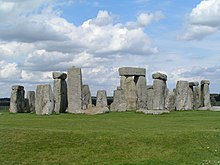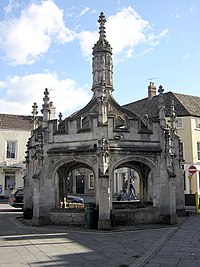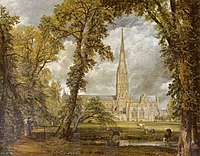History of Wiltshire
Wiltshire is one of the historic counties of England. It is located in the southwest of the country.
Prehistoric settlement
The prehistoric settlement is documented until the Neolithic . Wiltshire is extremely rich in prehistoric sites. The Salisbury Museum has a remarkable collection of stone and flint tools. Stonehenge, with its circle of giant stones, and Avebury, with its "road" of monoliths that lead to a former stone circle, are the largest and most famous megalithic sites in England and Europe.
A valley near Avebury is filled with huge blocks of sandstone that look like a river made of stones and may have been deliberately arranged by prehistoric architects. You can also find menhirs , dolmens and cromlechs there . Very early on, many people settled in the forests and swampy valleys of the Downs. Again and again one finds circular trenches, burial mounds and barrows in various shapes. Bones, ashes, objects, weapons and jewelry were found in these graves, some of which were divided into several stone chambers. On some hills of the county you can still see sloping terraces that are said to have been laid there by early farmers.
Historic fortresses can be found across the country. The best known are Vespasians Camp at Amesbury , Silbury Hill , the largest man-made hill in Europe at Avebury ; the hills of Marlborough and Old Sarum ; the camps of Battlesbury and Scratchbury at Warminster; Yarnbury , north of Wylye, which is almost perfectly preserved; Casterley , on a mountain trail about 10 km east-southeast of Devizes; Whitesheet and Winkelbury, across the Chalk Valley; Chisbury, at Savernake ; Sidbury, near Ludgershall ; and Figsbury Ring , 3 miles from Salisbury. Ogbury, 9 km north of Salisbury, is without a doubt an early British settlement. Durrington Walls , north of Amesbury, may be the remains of a settlement, some of which can still be found on Salisbury Plain and Marlborough Downs .
Settlement since the beginning of history
Contemporary settlement of what is now called Wiltshire began in AD 552 when the Saxons with their leader Cynric defeated the British at Old Sarum . This cleared the way to settle Salisbury Plain.
Four years later, Cynric advanced through the Valley of Pewsey and, with his victory at the Battle of Barbury, extended the borders of the West Saxon (Wessex) kingdom to the Marlborough Downs. At the time, the landscape south of the Avon and River Nadder was densely forested. Remnants of it can still be seen today at Cranborne Chase. As a result, settlement only took place along the Avon and River Wylye river valleys . This is where today's city of Wilton was founded under the name of Wilsaetan.
In the 9th century the area was so developed that an administration existed. A Walston, an Elderman of the Wilsaetan, is reported in the year 800 to prevent the troops from invading Mercia. Furthermore, Wiltunscire 878 is mentioned by the Welsh monk Asser in connection with an attack by the Danes, who opened their headquarters in Chippenham and pillaged the surrounding area for a year before they disappeared again.
At the time of Æthelstan there were mints in Old Sarum , Malmesbury , Wilton, Cricklade and Marlborough . Wilton and Salisbury were devastated in Danish raids under Sven Gabelbart in 1003 and by Canute the Great in 1015.
Land ownership after the Norman conquest of England
After the conquest of England by the Normans, there was a redistribution of property. More than 40% of the land went to the Church and 20% kept the crown. Much of the rest of the land went to Edward of Salisbury , William, Duke of Ewe, Ralf de Mortimer , Aubrey de Vere II , Robert Fitzgerald, Miles Crispin, Robert d'Oily, and Osbern Giffard .
The first Earl of Wiltshire under Norman rule was William le Scrope in 1397. Thereafter the title went to Sir James Butler (1449), Sir John Stafford (1470), Thomas Boleyn (1529) and Willam Paulet (1550).
Benedictine monasteries had been founded in Wilton, Malmesbury and Amesbury even before the Norman invasion. The Augustinian monastery in Bradenstoke was founded by Walter d'Evreux in 1142, the monastery in Lacock by the Duchess Ela of Salisbury in 1232. Sir John Vernon founded a monastery in Longleat before 1272. Other monasteries were Monkton Farleigh (Cluniac by Humphrey de Bohun in 1125), Kingswood, Gloucestershire (Cistercian by William de Berkeley in 1139) and Stanley Abbey (by Matilda of Boulogne in 1154)
Wiltshires "hundreds"
There were sub-units at the local level in almost all counties. Most counties were divided into hundreds. The Hundreds or their corresponding sub-units in other counties were for their part divided into tithings and parishes, the latter being an administrative unit to this day. These in turn were divided into townships and manors.
Of the 40 Wiltshire hundreds mentioned in the Domesday Book , Selkley, Ramsbury , Bradford, Melksham , Calne , Whorwellsdown, Westbury , Warminster , Heytesbury, Kinwardstone, Ambresbury, Underditch, Furstfield, Alderbury and Downton are in name as well practically unchanged from its extent.
Thorngrave, Dunelawe and Cepeham hundreds make up the modern hundred of Chippenham; Malmesbury hundred was the Domesday hundreds of Cicemethorn and Sterchelee, Highworth represents the Domesday hundreds of Crechelade, Scipe, Wurde and Staple; Kingbridge the hundreds of Chingbridge, Blachegrave and Thornhylle; Swanborough the hundreds of Rugeberge, Stodfnd, and Swaneberg; Branch the hundreds of Branchesberge and Dolesfeld; Cawden the hundreds of Cawdon and Cadworth.
Historic meeting places
Several historical gathering places are known to exist in Wiltshire today. The Swanborough meeting place was called the Swanborough Tump and was located on a small hill in the parish of Manningford Abbots. This place was identified as the one named by King Alfred the Great in his will.
Malmesbury's meeting place is in Colepark, Bradford-upon-Avon at Bradford Leigh, and Warminster at Iley Oak, about 2 miles south of Warminster, near Southleigh Wood. The county court was then held in Wilton and jurisdiction was exercised ex officio by the castellans of Old Sarum until 1446 . Malmesbury and Salisbury were later added as courts of law.
At the time of the inventory of all English possessions in the Domesday Book , Edward of Salisbury held the sheriff's office and passed it on to his family. The last incumbent in the family was William Longspee, who took over the office through his marriage to Ela, Edward's great-granddaughter.
Church administrative districts
When the West Saxon bishops were split up in 703, Wiltshire was assigned to the diocese of Sherbone until a separate diocese was established in Wilton in 905. The seat of the bishop moved regularly between Ramsbury , Wilton and Sonning in Berkshire at this time .
Shortly before the Norman conquest of England, Wilton was reunited with the Diocese of Sherbone. The archdeacons of Wiltshire and Salisbury are mentioned in sources dating back to 1180. In 1291 the deaconry of Wiltshire included the deaneries of Avebury , Malmsbury, Marlborough and Cricklade and the deaconry of Amesbury, Potterne, Wilton, Chalke and Wylye as part of the Salisbury archdeaconry.
In 1535, the Archdeaconry of Salisbury received the Deanery of Salisbury, while the Deanery Potterne changed to the Archdeaconry of Wiltshire. The deaconies of the Salisbury Archdeaconry have survived to this day, while the Wiltshire Archdeaconry now includes the deacons of Avebury, Marlborough and Potterne. The deaneries of Chippenham, Cricklade and Malmesbury now form part of the Archdiakonie and Diocese of Bristol .
Early history
The people of Wiltshire have always been hardworking rather than bellicose, so there is little to say about the county history. Just like other regions of the country, the county was only affected by major national events.
After the Domesday Book was completed in 1086, all landowners gathered in Salisbury to swear allegiance to the king. In 1116 there was another such meeting.
In Clarendon Palace , a contract was drawn up in 1166, which laid down the local court administration.
Sessions of Parliament were held in the county in Marlborough in 1267, and in Salisbury in 1328 and 1384.
During the wars of King Stephen's reign, Salisbury, Devizes and Malmesbury were occupied by his opponent, Bishop Roger of Salisbury . In 1138, Stephan was able to arrest the bishop under a pretext and capture the castle of Devizes.
The English Civil War
Wiltshire actively supported the side of Parliament during the English Civil War in the 17th century. This partisanship was accompanied by violent anti-Catholic riots and attempts by the Marquise of Hertford and Lord Seymour to create a mood in favor of the king. However, the population opposed this request.
In the first phase of the war the royalists were successful and took Marlborough in 1642. In 1643 the troops of the Earl of Essex were defeated by the King and Prince Rupert at Aldbourne and that same year Sir William Waller was defeated at the Battle of Roundway Down after the unsuccessful attack on Devizes .
In 1645 a vigilante-like force developed, the so-called "Clubmen" (i.e. club swingers) of Dorset and Wiltshire, who, with the aim of making peace, systematically punished every soldier if they discovered him plundering. It was irrelevant whether the person belonged to the parliamentary party or the royalists.
Devizes, the last royalist fortress, was taken by Oliver Cromwell in 1645. A loyal rebellion in Salisbury was put down the following year.
economy
In the days of the Domesday Book , Wiltshire was a purely agricultural county. 390 mills are mentioned in the book, as well as vineyards at Tollard Royal and Lacock. An intensive sheep farming developed in the following centuries. Monks from the Cistercian monasteries of Kingswood and Stanley exported wool to Florence and the Flemish markets in the 13th and 14th centuries. Wiltshire was then considered to be one of the most important counties in which clothing was made. The centers of the wool industry were Bradford-on-Avon , Malmesbury , Trowbridge , Devizes and Chippenham .
In the 16th century, Devizes was famous for the woolen blankets it produced, Warminster was known for its grain market and North Wiltshire was a center of cheese production. Amesbury was famous for its tobacco pipe factories.
In the 17th century, the clothing industry fell into crisis, particularly due to the multiple outbreaks of the plague. Other goods that were made in the region included linen, cotton, gloves and cutlery. In Malmesbury, silk was processed and Wilton carpets were made.
County Parliamentary Representatives
In 1295 Wiltshire was represented by no fewer than 28 MPs. The county sent two knights, and the parishes of Bedwin, Bradford, Calne, Chippenham, Cricklade, Devizes, Downton, Ludgershall, Malmesbury, Marlborough, Old Sarum, Salisbury and Wilton two citizens each. However, it often happened that the municipalities only reported irregularly.
Hindon, Heytesbury and Wootton Bassett were also allowed to send MPs in the 15th century.
At the time of the Reform Act 1832 , which reorganized the constituencies, the county had 16 parishes with a total of 34 MPs. This law deprived Great Bedwin, Downton, Heytesbury, Hindon, Ludgershall, Old Sarum and Wootton Bassett parishes of their own MPs and reduced the number of MPs at Calne, Malmesbury, Westbury and Wilton.
In 1868 laws were passed again, according to which Chippenham, Devizes and Marlborough also lost an MP.
In the reorganization in 1885, the county sent five MPs and the parishes of Cricklade, Caine, Chippenham, Devizes, Malmesbury, Marlborough, Westbury and Wilton were withdrawn from their own MPs. Salisbury's number of MPs was reduced by one.
Roman finds
Even today there are many remnants of Roman rule in England. Wansdyke or Wodens Dyke is one of the largest preserved fortifications. This facility stretches over 90 km from a place east of Savernake to almost the Bristol Channel. For several miles in the Marlborough Downs it has retained its original appearance. It is difficult to classify it in time, but excavations have shown that the fortification dates from the time of the Roman occupation or the Romano-British period.
The fortification consists of a hill with a moat on the north side. Its function as a defensive structure is obvious. It was by no means only intended as a border. Fortifications are regularly found on the fortification. Another similar facility is Bokerley Dyke , largely on the border between Wiltshire and Dorset ; it is the largest of several similar fortifications and has an additional moat north of the defensive wall.
Church buildings
Monastery ruins
The most famous monastic buildings of which remains can be found are the ruins of Malmesbury Abbey and Lacock Abbey near Melksham. There are still traces of a hospital for leprosy women at Maiden Bradley, which was later converted into an Augustinian convent. On the border with Somerset at Monkton Farleigh, a Cluniac monastery was founded in the 13th century, which initially served as the hermitage of the main monastery in Lewes. A few outbuildings can still be seen today. In Edington a monastery was founded by Bonhommes in 1347, which was initially inhabited by a dean and 12 benefactors. The decorated style and perpendicular style monastery church has the size and fittings of a cathedral.
In the 14th century the buildings of Bradenstoke Abbey and Clack Abbey were erected at Chippenham. They served as residence for canons of the Augustinian order. Bradenstoke Abbey was inhabited by them until 1929. Then the publisher William Randolph Hearst bought the property and had most of the buildings demolished. He then used the stones for St Donat's Castle , his property in Glamorgan , South Wales . The monastery's tithe barn was also demolished and shipped to San Simeon, California, where it would be rebuilt at Hearst Castle. Hearst, however, lost interest in it and sold the material. It was recently rediscovered - still in pieces - and efforts are being made to retrieve the stones and rebuild the barn in Bradenstoke.
Notable churches
The most remarkable churches in Wiltshire, mostly in the Perpendicular style, are found where the stones needed were easily available. In areas where you could only get limestone or flint, the architecture is rather simple.
Small pointed church towers and pyramid-shaped bell towers are not uncommon. The churches of Purton , 5 km northwest of Swindon and Wanborough 4.5 km southeast of the city each have two steeples, one in the middle and one on the west side.
The Church of St. Lawrence in Bradford-on-Avon is one of the most perfect ecclesiastical buildings of Anglo-Saxon architecture in England. Other Saxon remains can be found in the nave of the church at Britford near Salisbury, on the east side of the chancel at Burcombe near Wilton and in parts of the churches at Bremhill , Manningford Bruce and Braose in the Pewsey Valley.
The Church of St. John in Devizes still has its Norman tower and Norman stonework in the chancel. In the same place you can find the Church of St. Mary with its Norman decorated portal. The churches of Preshute near Marlborough, Ditteridge near Box and Nehter Avon near Amesbury also have various Norman characteristics.
An outstanding and unadulterated example of Early English architecture is Salisbury Cathedral, as well as the somewhat smaller churches in Amesbury , Bishops Cannings , Boyton in the Wylye Valley , Collingbourne Kingston east of Salisbury Plain, Downton and Potterne near Devizes.
The finest decorated-style church in the county is at Bishopstone in the Chalk Valley, with a quirky exterior cloister and unique exit at the south end of the chancel. This is located under a stone canopy.
In Mere , on the Dorset and Somerset border, you will find not only a Perpendicular style church , but also a medieval chapel, some of which was used as a schoolhouse, and 14th century houses.
Secular architecture
Castles
The castles in Wiltshire are almost all gone these days. At Old Sarum, Marlborough and Devizes, few remains are found in the walls and vaults. The castles at Castle Combe and Trowbridge were destroyed early on, and only fragments remain of Ludgershall Castle. The ruins of Wardour Castle are in a densely wooded park near Tisbury and some date from the 14th century. They consist of a high, hexagonal outer wall that encloses an inner courtyard.
The entrance area is dominated by two towers and 1.5 km away, behind a park, is the 18th century castle. It is famous for its collection of paintings and, among other rarities, for the Glastonbury Cup, a cup that, according to legend, was carved from a branch of the thorn tree in Glastonbury .
Mansions
The number of mansions, manors and castles is a hallmark of Wiltshire. There are few parishes, mainly in the northwest, that do not have a mansion within their boundaries. Nowadays these have mostly been converted into farms. However, the stone-covered roof, the stone central posts of the windows, the gable front, the two-story porch and the oak-clad interiors are often still preserved.
Place House in Tisbury and Barton Farm in Bradford-upon-Avon date from the 14th century. Typical examples of 15th century architecture are best seen in the mansions of Norrington Manor in the Chalk Valley, of Teffort Evias in the Nadder River Valley ; Potterne and Great Chaldfield at Monkton Farleigh. There is a mansion in South Wraxall from this period, in the hall of which, according to tradition, Sir Walter Raleigh and his host Sir Walter Long smoked tobacco for the first time in England.
Later architectural styles can be found in Longford Castle near Salisbury, in Heytesbury House; at Wilton House in Wilton , Kingston House near Bradford-upon-Avon , Bowood House near Calne , Longleat near Warminster , Corsham Court in Corsham , Littlecote near Ramsbury , Chariton House near Malmesbury , Compton Chamberlayne in the valley of the Nadder, Grittleton House and the modern Castle Combe , both at Chippenham and Stourhead , on the Dorset and Somerset borders . Each of these properties is worth mentioning for its architecture, its art treasures and its outdoor facilities.





